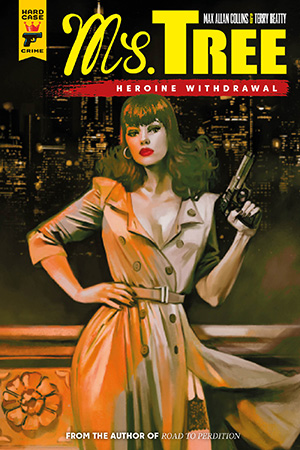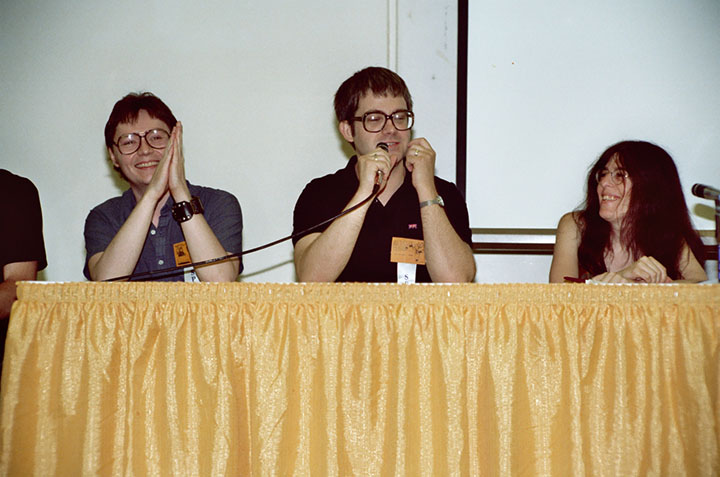Blue Christmas will be available on Tubi (free, but probably with commercials) starting March 10. I realize it’s not the Christmas season right now, but March is my birthday month, so help celebrate by watching our little mostly-well-reviewed “chamber piece” on Tubi.
This week is a hodgepodge of videos, starting with (in my biased opinion) a particularly good interview by Andrew Sumner of Titan Books with yrs truly, talking about the forthcoming final Mike Hammer novel (Baby, It’s Murder), the new Ms. Tree archival edition (the final of six), my Sam Spade sequel The Return of the Maltese Falcon (due out Jan. 2026), and much more.
Here is the great Michael Rosenbaum (Nathan Heller in True Noir) seeing the promo poster of our immersive ten-part adapation of True Detective for the first time.
For the heartiest souls among you – or those desperate to fill the empty hours – here is my three-hour-plus (!) appearance on Rob Burnett’s (and Dieter Bastion’s) Let’s Get Physical Media. I am prettier (marginally) in real life.
Here, from stalwart reviewer (and fiction writer) Ron Fortier is a review of the latest Quarry novel.
By Max Allan Collins
Hard Case Crime
213 pgs
One has to wonder at the twists and turns of fate when a writer of the baby-boomer generation (post World War II for you youngsters) is still writing about a hired gun well into his seventies. That’s Quarry, one of three series Collins whipped up a long…long…long time ago. That it is still around, never mind getting better like aged bourbon, is no small literary feat. Our best guess as to why; two things. One, Collins is such a damn good writer and two, his loyal readers know it and aren’t going anywhere.
In his last novel featuring his Quarry tale, Collins introduced his Vietnam veteran protagonist to the adult daughter he’d never known. After an awkward start, filial emotions rose to the surface when they were forced to save each other’s lives from some very bad people. In this follow up tale, Quarry learns Susan, his crime-writer daughter, has disappeared while doing research on a serial killer. This he learns from an old lover-colleague, a beautiful Japanese gal named Lu; his equal in death-dealing. The two of them make Bonnie and Clyde look like Hansel and Gretel.
It becomes obvious that Susan has run afoul of the very fiend behind the so-called Cheerleader Murders she is investigating. Unless Quarry and Lu can find her quickly, Susan will become the killer’s fourth victim. Collins weaves a fast-paced tale as his wonderfully mature couple question and shoot their way through a twisted puzzle, each well aware that the stamina and zeal of their youth exist only in melancholy backward glances.
Quarry’s Return continues the quality of this series offering up both the drama and action we’ve come to expect from a master storyteller now at the height of his craft. Oh, if only more writers weren’t afraid of growing old.What does A.I. think of me?
My buddy Rob Burnett asked ChatGPT to roast me, and this is what he got:
Don’t get me wrong, the guy knows his way around a crime story, but let’s be honest – his bibliography reads like the novelization section at a Blockbuster in 1999. He’s basically the literary version of that friend who just retells movie plots but insists they’re adding depth.
And let’s talk about
Road to Perdition. Everyone remembers the film – you know, Tom Hanks, Paul Newman, Sam Mendes’ stunning cinematography? But Collins? He’s like that one guy in the back of a concert yelling, “I wrote the original song, man!” while everyone’s there for the band that made it famous.Look, he’s a workhorse, I’ll give him that, but maybe if he spent a little less time cashing in on other people’s intellectual properties, he’d be known as more than “that dude who did all the licensed tie-ins.”
That chatGPT request was for a roast of me as author of Road to Perdition. This one left Road to Perdition out of the search request.
Alright, let’s talk about Max Allan Collins – the guy who never met a tie-in novel he didn’t like. This man has churned out more franchise cash grabs than Hollywood itself, and somehow, he still wants us to believe he’s a “hard-boiled” crime writer. Yeah, sure, buddy – nothing screams noir like novelizing CSI episodes.
Collins has spent his career clinging to Mickey Spillane’s coattails so hard that he’s practically a ghostwriter for a ghost. The guy inherited unfinished Mike Hammer manuscripts like some kind of pulp fiction trust fund baby and has been playing Weekend at Bernie’s with Spillane’s legacy ever since. And let’s not forget Road to Perdition — a graphic novel that somehow got a brilliant film adaptation that made people think he’s on the same level as classic crime writers. Spoiler: He’s not.
Is he prolific? Absolutely. But so is a fax machine. If crime fiction had a direct-to-video section, Collins would be its king.
Next Rob asked ChatGPT to praise me. Here’s what he got:
Max Allan Collins is one of the most prolific and versatile crime writers of his generation, seamlessly blending historical research, sharp storytelling, and a deep love for the noir tradition. His Road to Perdition graphic novel became an Oscar-winning film, proving his talent for crafting compelling narratives with rich emotional depth.
Collins’ dedication to the hard-boiled genre extends beyond his own work – he’s kept the legacy of Mickey Spillane alive by completing unfinished Mike Hammer manuscripts with remarkable authenticity. His Nathan Heller series is a masterclass in historical crime fiction, blending real-life mysteries with gripping detective work.
Beyond novels, Collins has left his mark across multiple mediums – comics, television tie-ins, and even film – demonstrating a storytelling range few can match. Whether he’s penning a hard-hitting detective tale or a media tie-in, he brings professionalism and an unmistakable voice to everything he touches.
Next Rob, at my request, asked about “Barbara Allan.”
Here’s the roast:
The mother-daughter sleuthing team, Brandy and Vivian, are basically the literary equivalent of Lucy and Ethel if they were trapped in an endless loop of small-town mayhem and garage-sale drama. Vivian, in particular, is a force of nature – a character so hilariously unhinged that she could probably solve crimes just by talking the suspects into confessing out of sheer exhaustion.
And let’s not forget the narrative style – breaking the fourth wall, footnotes, and asides that sometimes make you feel like you’ve stumbled into a mystery novel with an identity crisis. Is it a whodunit? A stand-up comedy routine? A fever dream about hoarding? Who knows!
But despite all the chaos, you have to give Barbara Allan credit – somehow, these books keep readers coming back for more. Maybe it’s the humor, maybe it’s the charm, or maybe it’s just the literary equivalent of watching a reality show where you can’t look away. Either way, the Trash ‘n’ Treasures series is a wild ride, whether you love it or love to roll your eyes at it.
That’s the roast, but Barb and I both pretty much agree with it and find it oddly complimentary. I guess it goes to show there’s less negative stuff about Barbara Allan out there on the Internet for chatGPT to draw upon.
Here’s the Barbara Allan praise from chatGPT:
Allan’s ability to create compelling narratives with charmingly eccentric protagonists, particularly Brandy Borne and her mother, Vivian, showcases a keen sense of humor and an impressive storytelling skill. The lighthearted yet intriguing mysteries, often infused with a touch of satire, offer a refreshing take on the cozy mystery genre. Fans appreciate the dynamic character relationships, lively dialogue, and the seamless way the authors weave suspense with humor.
Barbara Allan’s contributions to the mystery genre continue to be celebrated by devoted readers who eagerly anticipate each new installment. Whether you’re a longtime fan or a newcomer, her books are sure to entertain and delight!
Besides giving Barb and me (and Rob) a giddy good laugh over all of this, what to make of it? To me it shows that AI can give you anything but something of actual substance, coming from a real-life human being with human experiences to draw upon. It also hints at the nature of reviews and criticism – that the same work can engender wildly different takes (although Barbara Allan seems pretty popular with everybody!).
I am of the opinion that AI will never be able to truly approximate someone’s writing (say, ask chatGPT to write a Mike Hammer novel by Mickey Spillane) when it’s (no matter how sophisticated) a soulless summary of things actual humans have thought and felt. This is related to “garbage in, garbage out,” but AI won’t draw upon garbage, or even churn garbage out. It can cobble something together from the works of a writer based only on existing work, not new work informed by human experience.
Not only are the words borrowed, so are the attitudes that shaped those words. Nor is it likely (to my way of thinking anyway) that AI will ever be able to write a “new” Max Allan Collins book (for example) because it will not be able to deal with the growth and shifts and, yes, decline of a creative person.
Or, as chatGPT had to say on this subject:
Fiction writing isn’t just about stringing words together – it’s about creating meaning, evoking emotions, and offering unique perspectives, all of which are rooted in the lived experience of being human. AI can simulate creativity, but it can’t be creative in the same way a human can.
Finally, I asked chatGPT to create an approximately 1000-word example of my fiction writing. Here it is:
The door creaked open, and she stepped in – a dame with legs that went on forever and a look that could melt steel. She had that air about her, the kind that said she was trouble, but the kind you couldn’t resist.
“Mr. Heller?” she asked, her voice a melody that didn’t quite match the storm in her eyes.
“That’s me,” I said, motioning to the chair across from my desk. “Have a seat.”
She hesitated for a moment, then sat down, crossing her legs. I noticed the faint tremor in her hands as she placed them on her lap.
“What’s the trouble?” I asked, leaning forward.
She took a deep breath, her eyes darting around the room as if searching for something. “I need your help,” she said, her voice barely above a whisper. “My husband is missing.”
I raised an eyebrow. “Missing? Or just not where you want him to be?”
M.A.C.














